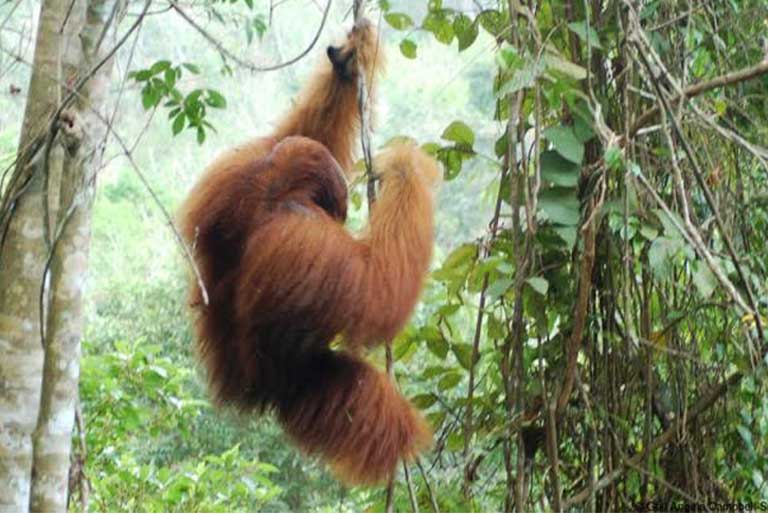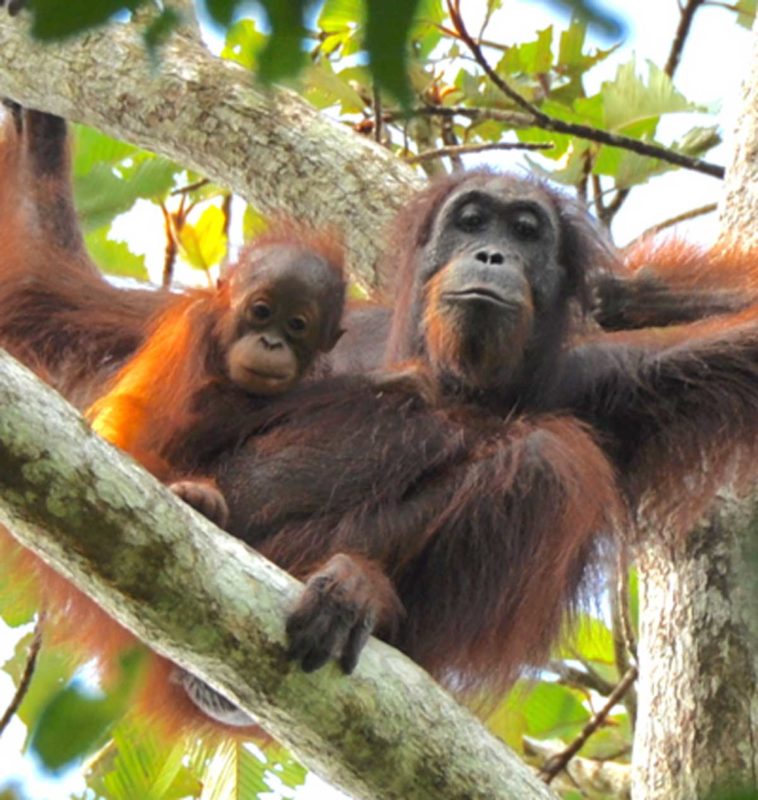- Orangutans are in drastic decline, largely due to habitat loss. From 1973–2010, Borneo lost 39 percent of its forests; estimates say that another 37 percent of orangutan-suitable habitat will be converted to agricultural use there through 2025. Similarly, 60 percent of habitat suitable for Sumatran orangutans was lost between 1985 and 2007.
- If orangutans are to survive in the wild through the 21st century, researchers will need to discover ways in which the animals can be helped to coexist with humans within agricultural landscapes. Researchers are also looking for creative ways to provide connectivity between remaining forest patches to promote and preserve genetic resilience.
- Scientists Gail Campbell-Smith, Marc Ancrenaz and others have shown that orangutans can use croplands, including oil palm plantations, if humans work to prevent conflict. Noise deterrents, such as bamboo cannon guns, along with the education of farm laborers and agribusiness companies, are techniques helping to reduce animal-human conflicts.
- Researcher Marc Ancrenaz and colleagues provided orangutans and other arboreal wildlife with rope bridges over small rivers in Malaysia — a successful approach to providing connectivity. It took four years for orangutans to begin using the bridges, but now young orangutan males use the structures to disperse more widely.

Critically Endangered orangutans live in a part of the world where pristine forest is rapidly disappearing under human cultivation. From 1973–2010, Borneo lost 39 percent of its forests, and estimates are that another 37 percent of orangutan-suitable habitat will be converted to agricultural use there through 2025. Similarly, 60 percent of habitat suitable for Sumatran orangutans was lost between 1985 and 2007. If current trends continue, both species will have decreased in numbers by over 80 percent by 2025 — with habitat loss still being one of the greatest drivers of that decline.
So it is vital, if these great apes are to survive for decades to come, to understand how we can help them coexist alongside and among us today, especially within the agricultural landscape.
It was previously assumed that forest-dwelling orangutans wouldn’t be able to adapt to living in human-altered croplands. But more recently, researchers have conducted studies that have come to somewhat more encouraging conclusions.
Work by Marc Ancrenaz, Gail Campbell-Smith and their colleagues has shown that, in some cases, orangutans can make use of croplands, including oil palm plantations, if humans work to prevent conflict appropriately. Both scientists are also seeking solutions to the issue of forest fragmentation — helping animals to more easily travel between remaining patches of forest habitat.
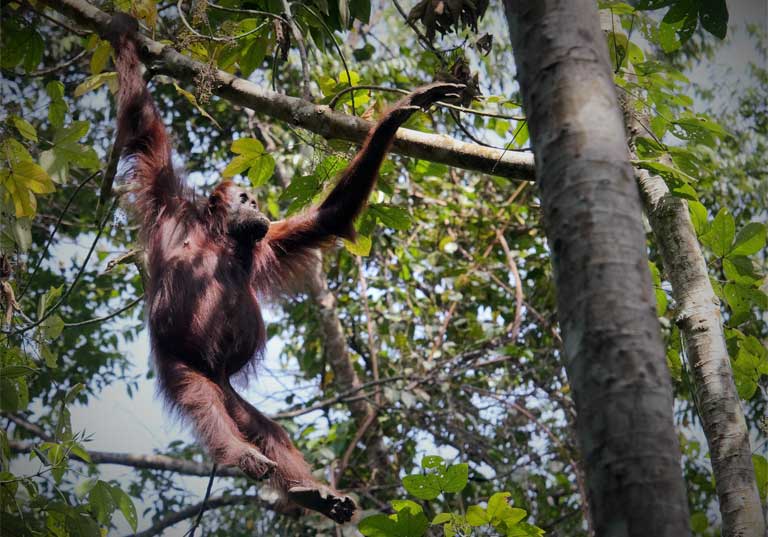
Bridging the gap
There’s growing awareness that conservation can’t rely exclusively on protecting, and leaving alone, what little natural habitat remains. Conservationists must also think about how to modify human-disturbed landscapes to help wildlife survive there, and to aid animals in moving through agricultural lands from one piece of good habitat to another.
In many parts of the world, wildlife corridors and artificial wildlife bridges are catching on, and researchers are finding that a habitat connectivity-assist that can work for the Florida panther or Gee’s Golden langur in India can work for orangutans too.
For example, the removal of large forest trees along the major tributaries of the Kinabatangan River in Sabah, Malaysia, meant that populations of arboreal species, such as orangutans and gibbons, would be trapped on one side or the other of the streams.
“Orangutans cannot swim, so what they do when they want to cross small rivers is to use natural bridges, like big trees whose branches are creating bridges over rivers,” says Marc Ancrenaz, scientific director at HUTAN, The Kinabatangan Orangutan Conservation Programme (HUTAN-KOCP) “When the large trees that are bordering the river are cut down, these natural bridges disappear, so the orangutans cannot cross anymore.”
Ancrenaz and his colleagues found a novel solution to this problem with an unexpected source: “We visited the National Zoo in Washington, D.C. and saw the orangutans were using artificial bridges to move across the zoo,” Ancrenaz recalls. There, on what’s known as the O-Line, orangutans swing over the heads of delighted zoo visitors on cables that stretch from one building to another.
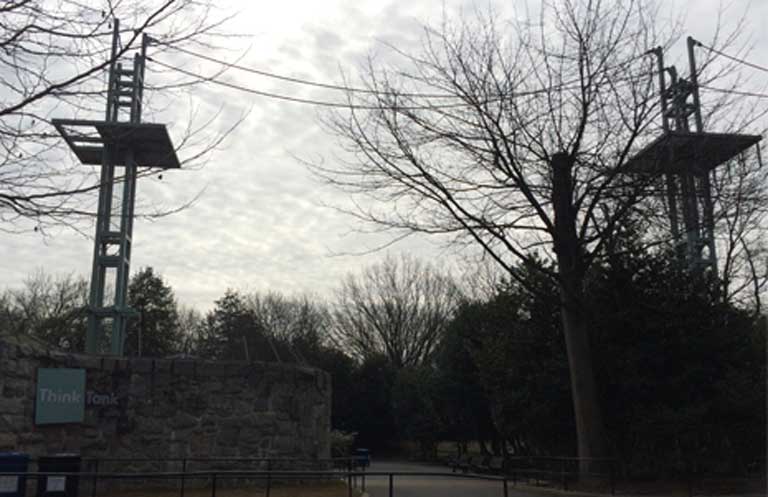
The HUTAN-KOCP team went to work back in Sahah, and used old fire hoses donated by Japanese zoos to construct several styles of bridge over the Kinabatangan tributaries; some were simple with just one or two ropes, others more complex.
While some species started using the bridges almost immediately, orangutans appeared more cautious. “For the first few years, monkeys were using these bridges a lot — macaques, proboscis, and other species. Orangutans and gibbons never used them,” he remembers. “Then suddenly, after four years, we started to see orangutans crossing.”
The bridges appeared to serve a different, but important, function for the orangutans. Monkeys commuted back and forth daily. In contrast, young orangutan males use the structures to disperse. This is critical in helping maintain the genetic diversity of great ape populations.
The Sabah bridges share something other than functionality with their original National Zoo O-Line inspiration: the Malaysian bridges have become a tourist attraction too, with people on boat cruises thrilled to look up and see wildlife moving across the rivers.
Like any human structure, maintenance is needed. The fire hoses degraded quickly, so they’ve been replaced by the more durable, non-biodegradable rope used to lash containers in place on cargo ships, an idea gleaned from another zoo. “It’s much lighter than the fire hoses, and once it’s set up the [ropes] last longer,” Ancrenaz says.
Of course, any conservationists inspired to employ this technique elsewhere need to be aware of a potential downside: the bridge-using animals are easily seen, which attracts people. “We don’t have much problem with poaching [in our area], but if you set these up in places where hunters are active, it’s a good spot for poachers,” he warns.
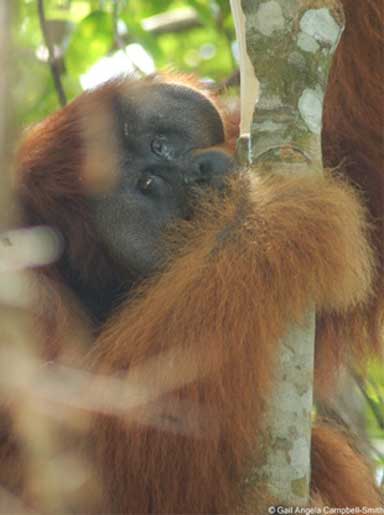
Life on the farm
While connectivity between remaining patches of forest is important for encouraging genetic resilience, more is needed to create a safe environment for day-to-day living, and mutually beneficial human-orangutan coexistence. A fully informed conservation strategy needs to consider how wildlife can utilize cultivated lands adjacent to forest habitat, and how to successfully mitigate human-animal conflict.
“In Sumatra, what I found was that local farmers could actually live in harmony with orangutans in their landscape,” says Gail Campbell-Smith, who studied humans and orangutan interactions in a part of North Sumatra, Indonesia where small farms predominated.
She saw that both sides were able to modify their behaviors in order to coexist: the animals could make use of crops for part of their diet and develop behaviors to avoid humans, while farmers could be persuaded to allow some crop loss via education and assistance with conflict mitigation.
When she first arrived on site, Campbell-Smith found an orangutan population that had been hanging on among the farms for over twenty years, though most had wounds from being shot at with air rifles.
“There was a level of tolerance — [the orangutans] were still alive and still breeding — but you could see from the pellet wounds that there had been some form of conflict,” she says. “I wanted to find out exactly what the conflict was, and how we could try to reduce it with strategies that were farmer-friendly, economically viable, and easy to do.”
“Easy to do” turned out to be critical to the project’s success. The most effective conflict-prevention strategy, for example, was to install a protective net system. While the nets preserved nearly 100 percent of the local fruit crop, farmers found it too labor intensive.
They much preferred the noise deterrent — a bamboo cannon gun, which could be used to steer the great apes away from farmlands. Although this method resulted in some crop loss, those small losses were acceptable to the farmers.
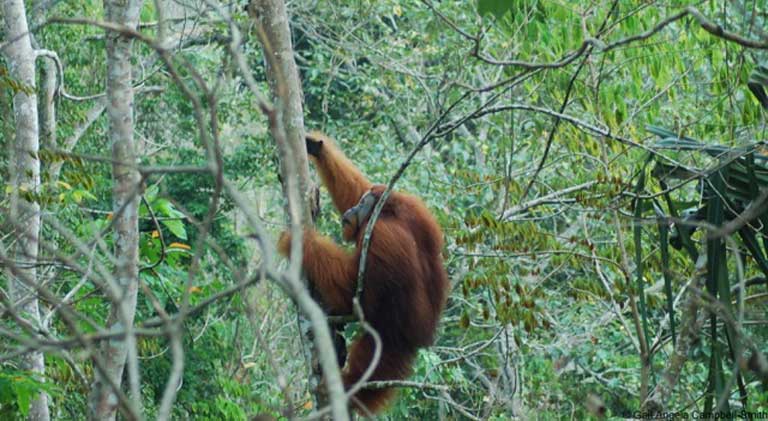
There was an unexpected but very welcome outcome to Campbell-Smith’s work: farmers who participated in the study ended up having a more positive attitude toward the orangutans. While most farmers previously wanted the great apes relocated, they now preferred to leave them be and to use strategies like the cannon guns to protect their crops.
On the orang-side of things, the scientist found that the animals had also adapted. They changed the timing of their foraging behavior, going after crops in the late afternoon or evening when nearly all the farmers had left the croplands and returned to their villages for the day. The result: conflict reduction.
The study found that the orangutans relied on cultivated crops for only about 21 percent of their diet, showing that continued access to adjacent forest fragments for wild food was still critical.
While it’s good news to know that human-great ape coexistence can work, Campbell-Smith emphasizes that connectivity is also essential for long-term survival. Without it, orangutan populations are too small and isolated, and genetic resilience is lost.
“They can live in these alternative [human dominated] landscapes, but it’s not the best habitat for them. If there’s enough food, they will survive and breed, but they also have to have genetic flow. If they’re isolated they’re not viable [in the long term].”
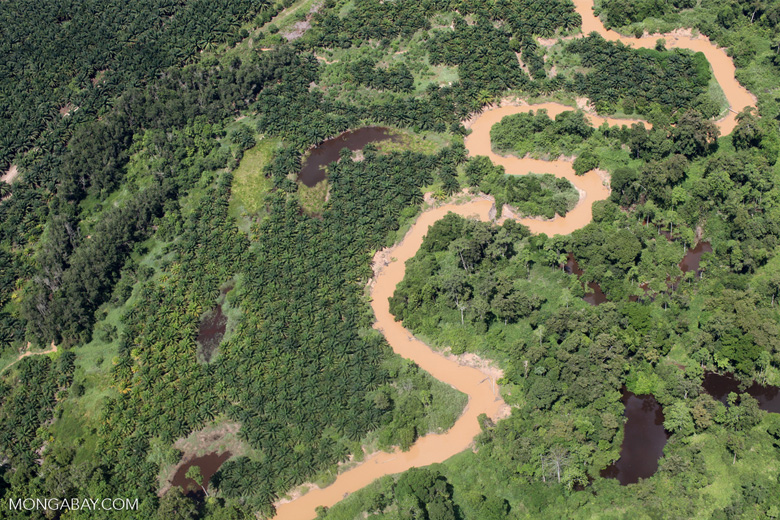
Life in the oil palm trees
One type of agriculture rapidly replacing orangutan habitat is tree plantations — particularly oil palm plantations. And Ancrenaz and his colleagues are finding orangutans are doing better here too, within these human-planted arboreal environments, than previously thought.
“We’re working at the interface of forest and oil palm plantation in mature forests,” he says. “We find that [orangutans] do fairly well [in mature oil palm trees] as long as they are not hunted.”
The animals generally stay fairly near the edge of natural forest patches. “They will go into the plantation, they will build their nests in the palms, spend a few hours in the plantation and then come back to the forest,” Ancrenaz says. But the orangutans also occasionally move long distances through the oil palm landscape: “Sometimes, some orangutans, especially the males, will go very deep into the plantation — just walk, walk, walk for miles.”
Similarly to the orangutans that Campbell-Smith studied, the mature oil palm plantation great apes learn to avoid people.
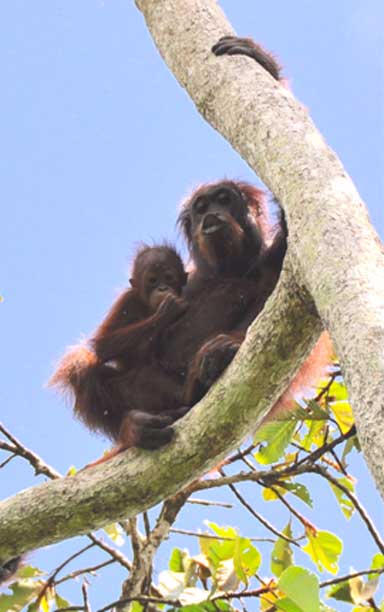
“The funny thing is, that when we speak to the workers, they most often don’t have any idea that orangutans are there,” says Ancrenaz. The oil palm plantation orangutans — like those on the small farms — have shifted their schedules to avoid conflict, becoming active in the very early morning or late afternoon or even at night, when workers have left the area.
Another important reason workers aren’t aware of the animals’ presence is that the great apes aren’t doing any damage. “What we see is that when orangutans are going into the adult palms, they are not impacting the production at all,” Ancrenaz says. “Which means that in theory at least, orangutans can use [mature] oil palm plantation for dispersal and a supplemental source of food as well, [so long as] people are not harassing them, and killing them, and as long as there is enough [adjoining] natural forest maintained in this [human-altered] landscape.”
Unfortunately for the great apes, the situation on mature oil palm plantations contrasts sharply with newly planted areas. When forest is first cleared, the orangutans’ natural food supply is destroyed, leaving only the young oil palm plants, and that is when most conflict occurs.
“At this time, orangutans are going into the plantations to feed on the shoots of the young palms and destroy them, and people are really upset and kill them,” says Ancrenaz.
At this stage, “coexistence” means moving the animals out of the plantation and away from the young plants as quickly as possible. Campbell-Smith — now the program director at International Animal Rescue (IAR) — is utilizing knowledge gained from her past work in Sumatra, and applying similar conflict avoidance methods in Borneo.
There, IAR is helping oil palm companies develop wildlife response plans, plans that include Campbell-Smith’s cannon gun noise deterrent. “Teams steer the orangutans back into the forest, so there’s no [crop] damage and no negative repercussions for the orangutans,” she says.
Long-term, the lack of negative repercussions is less sure, because orangutans eating young palms is a symptom of a bigger problem, habitat loss: “They only do that when there’s no fruit left in the little forest patches they are stranded in,” she says. “This is when conflict happens.”
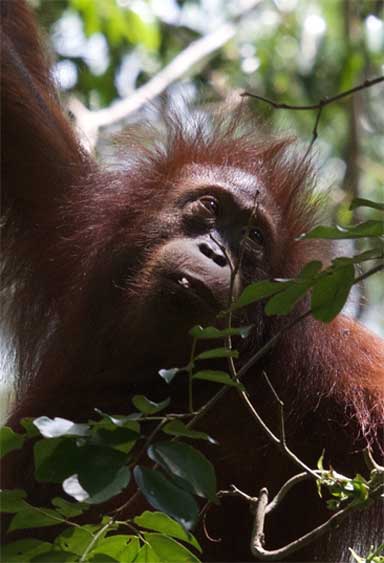
Planning ahead
The conflict-avoidance strategies developed by Ancrenaz, Campbell-Smith and others are proving useful, but those practice need to be spread more widely to help more orangutans. One thing that’s crucial is education for the people who do the actual coexisting.
It can come as a surprise to Westerners to learn that farm workers in Indonesia or Malaysia know little more about orangutans than we do. But that’s because these laborers rarely see these big animals. And when they do encounter them, they often panic, and overreact out of irrational fear — much as a Westerner might when encountering a bat flying about at night in a suburban home.
Campbell-Smith says that Asian women in particular are fearful of orangutans, partly based on folklore that the great apes kidnap and rape human females. And, interestingly, that fear affects how male farmers respond to crop damage — the researcher fond that farmers are far more tolerant of orangutans if none of their family is afraid of them.
But even without the misconceptions born out of folklore, orangutans are still big and potentially scary animals, and education is proving to be the key to not having a violent defensive response to their sudden appearance amid the oil palms.
Locals, says Campbell-Smith, need a better understanding of orangutan behavior and ecology. For example, in a human-altered landscape, the remaining trees often aren’t close enough together for the great apes to move freely through the canopy, so the animals may need to come down to the ground to get from one tree to another.
This is often the case when people and animal meet, with the human afraid of a potential attack, while all the orangutan wants is to get up the next tree and away.
“If you see them on the ground, just give them space,” Campbell-Smith tells people. “They’re an arboreal species. They only come to the ground when they have to. Most of the time, they want to get off the ground as quickly as possible.”
An understanding of basic animal behaviors is also necessary for farmers wanting to use conflict mitigation strategies effectively, even with something as simple as noise deterrence. “If you keep firing these [cannon] guns, and the orangutan has nowhere to go, you’ll make the [conflict] situation worse,” she says. “We train farmers to understand that they should look around and think about how the animal is going to move.” In this way, the apes can be safely steered away from crops and conflict.
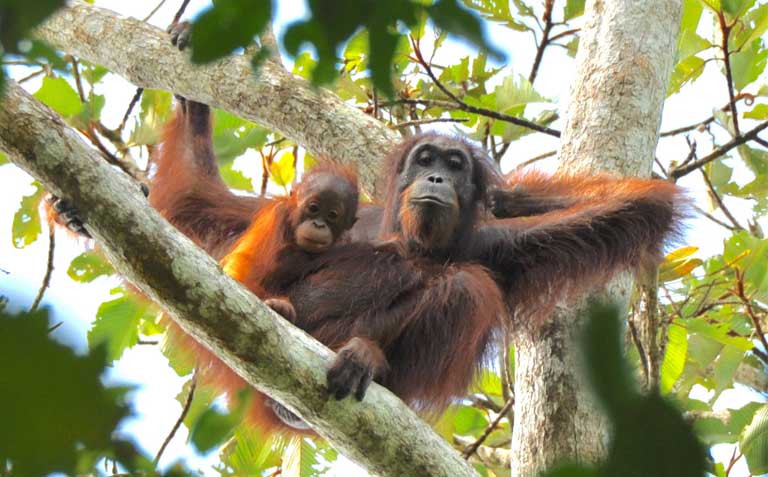
People often also simply need to learn about the plight these animals are in, so as to gain empathy. Some people in Campbell-Smith’s study area didn’t know that the great apes were endangered and protected by law, or how difficult it is to relocate orangutans because there isn’t enough forest left for them to move into. Having this information directly affected farmers’ attitudes: “They became more tolerant, the more knowledge they gained,” Campbell-Smith says.
The ideal, going forward, would be to stop destroying orangutan habitat. But given that this is unlikely — considering the global agribusiness and oil palm boom — then farmers, plantation workers, and the public will need to learn how to lessen impacts on the land, how to adapt agricultural lands to share them better with wildlife, and how to employ conflict-avoidance strategies.
Part of Campbell-Smith’s job now is working with agribusiness companies to help their employees think more about the forest fragmentation problem from the outset, and to plan how to allow for connectivity and coexistence.
“We encourage [the companies] to have a conservation mindset when they’re producing their business model,” she says. “It should not be an afterthought.”
FEEDBACK: Use this form to send a message to the author of this post. If you want to post a public comment, you can do that at the bottom of the page.
